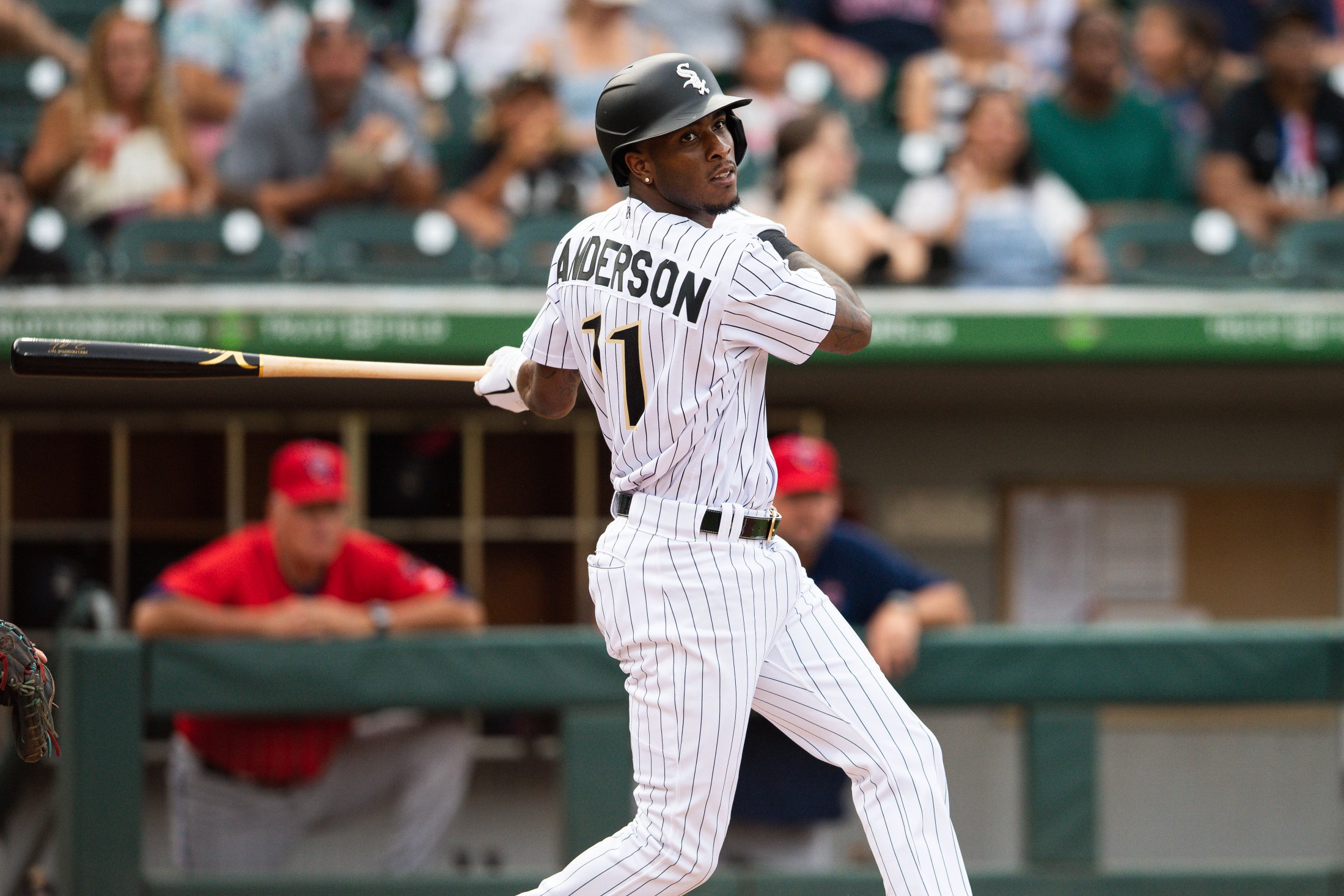When the White Sox first inked veteran outfielder Mike Tauchman during the winter meetings, the promise of his patient at-bats and on-base ability ran against the concern inspired by a spray chart, which suggested upon first glimpse that he might have lost the ability to pose a pull-side threat.

But upon signing, Tauchman cited windy conditions throughout the 2024 season at Wrigley Field dissuading a pull power-based approach -- an assertion backed up by Statcast data -- and said he intended to balance it out with the White Sox.
"You don't want to be one-dimensional as a player," Tauchman said. "Being able to make yourself a little harder to defend, be able to hit the ball all over the place, creates a little bit more opportunity."
As Tauchman himself points out, hamstring injuries have kept him from accumulating a sample size where meaningful conclusions can be safely made, even if he's hitting .288/.415/.530 in those 82 plate appearances. But as advertised, his chase rate is microscopic (20.2 percent), his walks (18.3 percent) are running even with his strikeouts (18.3 percent, too) and he's living on base at the top of the White Sox order. What might be more striking is how his spray chart has flipped.

Even while pulling the ball more than ever, Tauchman wouldn’t summarize his current mindset as a newfound devotion to a pull-and-elevate offensive approach, other than to acknowledge that "it's what a lot of guys are chasing."
"But I think that's more the result of being in a good position to hit, and I've gotten some pitches to do it on and I've executed on those swings, and so I'd like to try to continue that," said Tauchman, noting a shift in pitchers assessing their execution by stuff more so than location. "That forces me as an offensive player [to accept] you're never going to cover everything. You can't cover everything, every pitch, every spot. Identifying where pitches have to be for them to be good pitches for you to hit, I think it becomes even more important playing your strengths, rather than trying to cover what the pitcher is going to do. That's something that's not new for me, but at this point in the season my execution of that has been good. I'm happy with it."
Tracking the "why" to Tauchman's run of pull-side pop as a larger trend is tricky. It's also fleeting, because pitchers aren’t going to observe this level of success all year without a change in tactics. If you scan the progression of Tauchman’s eight-year major league career, the percentage of four-seamers he sees has plummeted, from a rate of roughly half the pitches thrown to him in 2017, to closer to 35 percent in 2025. It aligns with larger league trends over that time period, and more slow stuff offers more pitches to be naturally out in front of, and thus more pulling. But as he is wont to do, Tauchman takes that bit of information and turns it into a more granular observation.
As a rookie in Colorado, his playing time tilted more toward late-inning reserve appearances, and by nature, that meant facing a lot more relievers whose careers were built upon plus fastballs. Now as he's established himself as a regular later in his career, he encounters more full starter mixes. As is typical for left-handers with any degree of loft in their swing, he still often finds himself getting attacked with elevated velocity, but Tauchman would describe his progress on that front as borne out of developing a strong feel for where the top border the strike zone is, not swinging until he has to, and spoiling pitches when necessary. When he describes walks as a byproduct than a goal, this is an example of how his low chase rate is a defense to a common method of attack.
"He has a very unique perspective," said offensive coordinator Grady Sizemore. "He's been around a lot of good hitters, so I think there's a lot of value for our younger guys to kind of pick his brain and see not only how he comes up with a game plan, but also how he can make adjustments in the middle of a game. I think that's what some of these guys are still learning how to do."
Hitters can be cagey on their game plan, since so much of it is a mix between depending on scouting reports but also adjusting to what they're seeing mid-game. But Tauchman largely feels that having strong, observation-based ideas of what pitcher are trying to do against him and seizing upon it when he recognizes it is his source of catching balls out front and pulling them. And he can talk out some elements of his history that give him clues.
"Most organizations have philosophies pitching-wise," Tauchman said. "You can understand what that is because you see this team X amount of times and you can start to view how they like to do things. From my experience playing in Boston, they try to jam the hell out of you playing in Boston. Why? Because it's 400 feet to right field and they don't want left-handed hitters to play with the [Green] Monster. That makes sense for the ballpark, so that's an organizational philosophy that they have.
Other places do things differently. Tampa's at the forward-thinking end of what they're doing on the pitching side. Like, 'Hey, we're getting guys with weird outlier looks, outlier stuff and we're going to attack you with our A plans and we don't care who you are or how you hit that stuff, we want our pitchers playing to their strengths all the time.' So if you understand that, you can start to make more educated guesses on what they're going to try to do to you."
Tauchman flipped these examples to explain how a series against a struggling, veteran pitching staff in Baltimore became a difficult one, because the Orioles' protracted struggles led them to pitch counter to their scouting reports. That forced the young White Sox offense to rely more on in-game adjustments in a manner that Sizemore pointed out is newer for them. But as the 34-year-old outfielder talks about different attack plans around the league, it starts to sound like a demonstration of the benefit of experience.
"The league is getting younger and younger, so I think that experience has become something I've fortunately been able to rely on, because I've been able to gain it over the last few years or so," Tauchman said.
To put it another way, when optionality and cost-capped years of control are so highly valued by teams, who are always tracking performance metrics for indications that they can find a cheap facsimile of more established and thus more expensive players, maybe experience becomes a somewhat undervalued quality. Every team covets elite bat speed, but finding hitters who have gleaned enough from their time in the league to recognize their opportunities to pull can produce a similarly pleasing spray chart, at least for 82 plate appearances thus far.
"I mean, maybe," Tauchman said. "I don't think the smart people [are undervaluing experience]. I would never want to discount the value of playing the game and taking at-bats. Every at-bat, you learn something."
For Tauchman, knowing isn't just half the battle, but the part of the game he most enjoys. A more slug-heavy early batting line than anyone anticipated has been good for the White Sox and good for his next round of salary arbitration. Discerning the signal for how to drive the ball like he intended to this year from the noise of opposing pitching plans is the part of the game that's actually fun.
"The cat-and-mouse game is I have this approach coming into the game based on what [the pitcher] has done," Tauchman said. "Then is there a situation in the game where this is what he's doing right now. So do I stick with my approach thinking that he'll be the guy that he's been, or do I need to make that adjustment? That's part of it, too, knowing when what I thought coming into this game isn't happening, or he did these things unintentionally, or he's doing this to set other things up. And that's the really fun part of hitting."
Sounds frustrating, actually.
"It's both! But the frustration is what makes it more fun when you're on it. It's fun to be awesome all the time, but for a lot of us, you ride the highs and feel so good when it's going good, but you also know that I've been bad and that's not where I want to be. So when it's going right, you just ride the wave."






